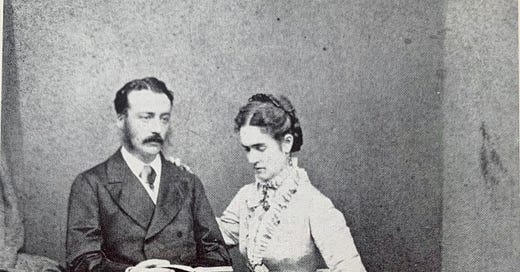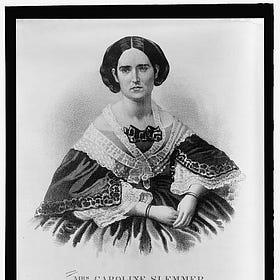On the way to a lovely summer wedding held in an English country garden last weekend, I spotted a bride and groom sitting on a bench at the Baker Street stop on the London Underground. As I took a snap of the happy couple (in a ray of celestial light from the window above) there was an audible ‘Aaaah!’ from the other train passengers who were also happy to witness a romantic kiss. Over one thousand people on Substack Notes have now enjoyed and commented on my photo, and it’s given risen to some intriguing theories of why the bride and groom picked this spot: was it a tribute to Sherlock or due to the proximity to Marylebone Registry Office? Did the couple first meet there, and will they celebrate their first anniversary by returning to this spot? (Click on the image below to find out more…) Meanwhile, it got me thinking about an unusual wedding ritual that took place for many years at Cambridge University, and my short post about it is below. Thanks for reading.
The Cambridge bride
The bride is led into the dining room. The candlelight throws warm tints on the dark auburn hair that is coiled high on her head, and her creamy skin seems to glow in the dim light. Her eyes are lowered demurely and her hand rests lightly on the Vice-Chancellor’s arm, as he gazes down at her in admiration. The other guests, men formal in their stiff wing collars, ladies in their dark dresses and diamonds, follow behind them in pairs, murmuring to one another and looking at the bride’s pearlescent grey silk wedding dress with its train of ruffles cascading to the floor behind her, rustling with every step. The couple proceed slowly to a long table laden with silverware, candles and flowers, and the bride takes her place at the head of the table. For one night only she is the most important woman in the room.
This is how I imagined Caroline Jebb’s formal introduction to Cambridge University society in October 1874. Caroline (née Reynolds) who was from Philadelphia, was a 34-year-old widow who had moved to England to marry the Irish classical scholar Richard Claverhouse Jebb, 33, in Shropshire in August 1874. On the couple’s return to Cambridge, where Richard was a Fellow of Trinity College, Caroline was amused rather than intimidated by the grand formal dinner held in Peterhouse College in her honour. She treated it as just another peculiar custom of English life, and was happy to have the chance to wear her astonishing wedding dress again.
In their official wedding photograph (see above) taken while they were on honeymoon in Wales in August, Richard leans against a lectern, holding an open book in front of him and gazing soulfully into the distance; Caroline’s eyes are lowered modestly. Perhaps she is meant to be listening attentively to him, but it’s not hard to work out what she’s really thinking about: how best to display her show-stopping wedding dress. It takes up more space than her new husband does, and she holds back the train to show the masses of expensively pleated pale grey silk, every fold and ruffle paid for with her own, carefully saved money.
For hundreds of years, one of the stranger traditions of the University of Cambridge was its way of welcoming the women who married its senior members. Until the late nineteenth century, only a handful of professors and college masters were permitted to marry. Having so few women connected to the university by marriage meant that each new Cambridge bride was formally welcomed with an elaborate ritual. This took the form of a grand dinner held in her honour hosted by the Vice-Chancellor (the head of the university) and attended by all the other senior university members and their wives.
The new bride was required to put on her wedding dress again, even if she had got married months or years before, and lead the procession to the dining table on the arm of the most senior man in the room. For one night only the Cambridge bride was elevated to the level of queen, and expected to be aware of the correct forms of conversation and etiquette. No particular importance was attached to the groom.
The American widow Caroline Jebb took all this in her stride, but it must have been terrifying for younger, less confident women. In her memoir Byways of Cambridge History (1947) Florence Ada Keynes recalled the embarrassment the formal dinner ritual caused to some of the younger brides.
‘For this occasion only, she was the leading lady; she had to be on the alert to catch the hostess’s eye when the suitable moment came for the ladies to withdraw, and hers it was to rise and precede the train of stately dowagers into the withdrawing-room.’
The Cambridge bride’s ordeal continued after this elaborate ritual, as she was then expected to invite all these imposing guests back to her own house, organize a seven- or eight-course dinner and understand the elaborate rules of precedence (much loved by Victorians) in deciding where everyone should sit.
In 1882 a new university legal statute permitted all college Fellows to marry; but the ritual of a Cambridge bride putting on her wedding dress and being welcomed with a formal dinner continued well into the twentieth century.
To many of these young women it must have felt that by marrying a Cambridge man they had married the university itself, and in some senses they had.
Now over to you. Have you ever heard of anything like this in your part of the world? Perhaps you did something different for your own wedding celebrations, such as having your reception in a London tube station? I’d love to know.
Notes
Lady Caroline Lane Reynolds Slemmer Jebb Papers at the Sophia Smith Collection, Smith College, Northampton, Massachusetts; Mary Reed Bobbitt, With Dearest Love to All: The Life and Letters of Lady Jebb (Faber, 1960); Florence Ada Keynes, Gathering Up the Threads (Cambridge: W. Heffer & sons, 1950).
Caroline's war
Hello! Welcome to Cambridge Ladies’ Dining Society. This is the first of a new series about the ‘back stories’ of the twelve members of the group before they moved to Cambridge in the 1870s and 1880s. This month’s post is about Lady Caroline Lane Reynolds Slemmer Jebb







As I've mentioned, Cambridge features in my novel. I always hold my breath when I read your posts, hoping I got the research enough correct. So far, so good. Thanks as always. Also bewitching photograph that is an excellent writing prompt.
Ann, this is both delightful and surprising. Who knew that Cambridge insisted for so long on treating its faculty like monks? When my mother was coming to terms with her exile from academia, the obstacle was not just her gender but her status as a faculty wife. I assumed that long tradition let men have it easy.